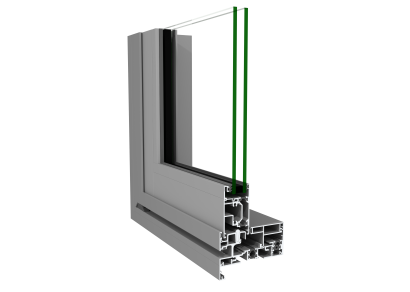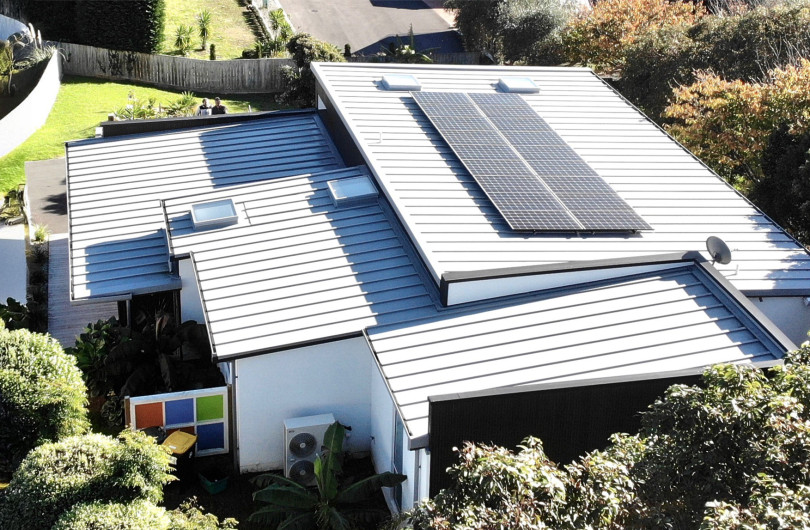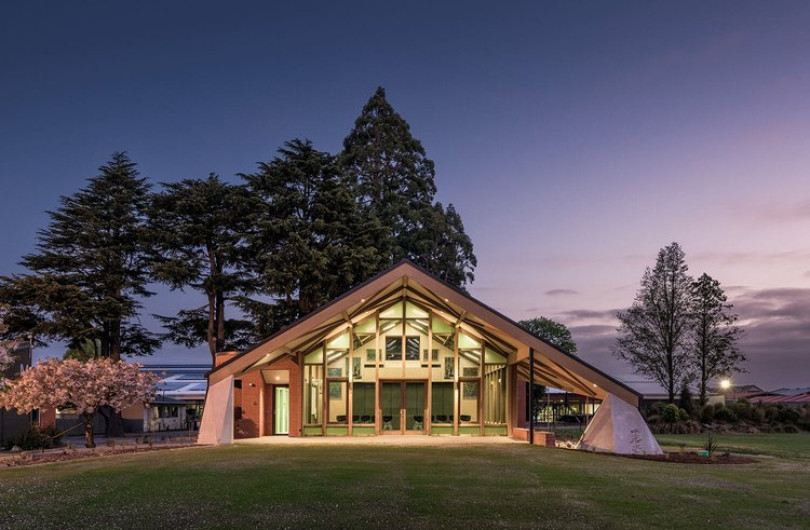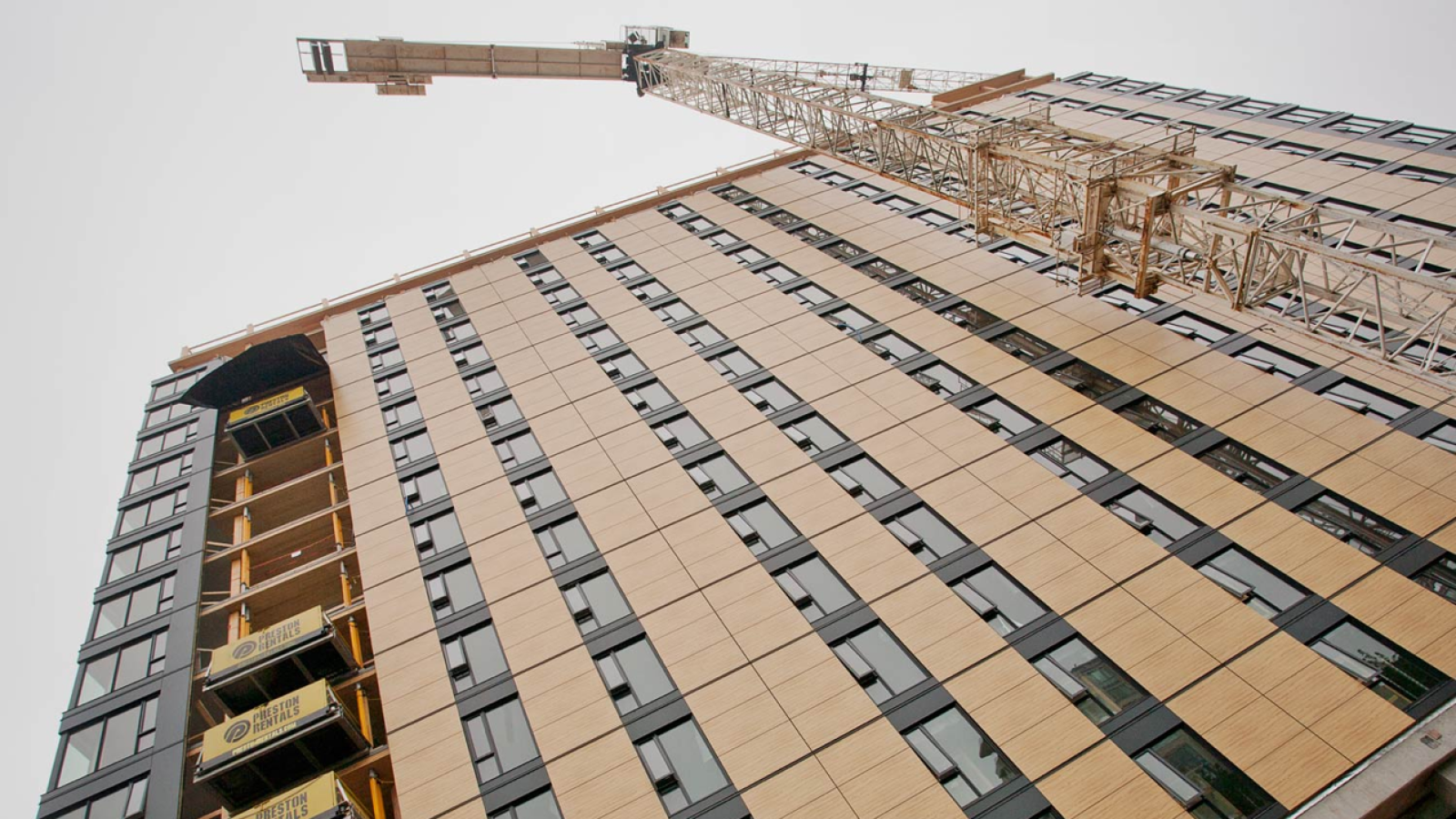Brock Commons featured the first hybrid mass timber construction in a high-rise residential building in North America. The innovative 53m tall university building — comprised of 18 stories, 16 stories of mass timber over a concrete podium with concrete stair cores — is often quoted as the benchmark for mass timber construction.
The goal of Brock Commons was to create a structure demonstrating that engineered wood products (EWPs) are a viable structural alternative in high-rise construction. Given the innovative nature of the project, a key driver in developing and detailing the design was to convince experts that the proposed solution would meet or exceed the requirements of the building code by utilising tried and tested solutions that were code compliant.
The primary reason for choosing a hybrid mass timber superstructure was that it was estimated to result in a building which is significantly lighter than its concrete equivalent. Innovation in construction and showing that a combustible substrate is safe to work with, as well as reduced overall costs were other considerations for the structure’s makeup.
The fire protection strategy
In the perception of the public and the authorities, the fire risk associated with any kind of combustible construction comprises a critical safety issue.
To mitigate this risk, the design team applied an ultra-conservative overall fire safety approach that utilised a combination of passive fire protection, active fire detection and suppression techniques, as well as measures to protect the building during construction.
While the overall fire-protection strategy and the interplay of its components is most certainly worth exploring, we want to focus on the passive fire protection design and why it was chosen.
The passive fire protection approach in the finished building is fourfold:
- Non-combustible construction: Concrete ground level and stair/elevator cores serve as the exits for the upper levels
- Controlling the fuel load: No significant exposure of the wood structural elements
- Encapsulation: Full encapsulation of the timber structure* (Interior wall and floor assemblies incl. connectors) with rigid board and concrete toppings, as well as the beams and columns
- Fire-separation measures: 2h FRR between each floor level and for all vertical shafts (no interconnected floor space) as well as the residential units. 1h FRR between the units and the pressurised corridor.
The passive fire protection challenge and solution
At the time Brock Commons was built the British Columbia Building Code (BCBC) did not allow for combustible construction (e.g., mass timber) for residential buildings higher than six storeys (or 18m high) and greater than a maximum building area of 1,200m².
However, Brock Commons is housed on the campus of BC University and the university’s council has jurisdiction in regulating buildings and developments on its property. Therefore, they have the authority to make project-specific amendments in line with their own codes, standards, policies, and regulations and by ensuring occupant health and safety protection is equal to or better than that provided in the BCBC for non-combustible construction of this size.
There were two specific aspects that the designers and consulting engineers were looking to get approval for that were not covered by the BCBC:
- The use of a mass timber construction in a high rise application.
- Keeping substrate-specific characteristics such as char-ability and how mass timber responds in a fire, out of the picture
The fact that budget and time constraints precluded the degree of fire testing that would have been necessary to demonstrate that the design could meet or exceed the level of fire performance required, and knowing the innately conservative code officials, an ultra-conservative suggestion was brought forward that lent itself to an easy and expedited approval process.
The design team decided to use the same approach to mass timber members as attributed as acceptable by the code for non-combustible construction, therefore not considering the substrate and its inherent fire properties, but treating the timber members as if they were steel or concrete members. These are all protected by either fire retardant coatings or encapsulation through gypsum board.
As a result, the design team opted for an ultra-conservative approach by encapsulating mass timber with a minimum of three layers of Type X gypsum boards (equivalent to GIB Fyreline). This conclusion was however not brought forward due to specific testing but through basic engineering principles using mere calculations that suggested that these three layers would achieve a 2-hour one way fire resistance rating.
An expert panel afterwards evaluated the structural and fire safety of the final design and decided that it had achieved a level of safety that was the same or better than that for a building of non-combustible construction, notwithstanding the use of mass timber elements.
For this reason, the Brock Commons design was accepted as being code compliant and exempted from the hindering parts of the BCBC. A site-specific regulation was issued, applicable to this very project only.
However, even-though compliant, the resulting passive fire protection strategy has two major flaws:
- It is not substrate-specific
- It was not fire tested.
We want to discuss why this approach was detrimental not only to the applied passive fire design but more so to the overall goals of the project (low costs, reduced weight, safe site and innovation), and show why testing would have offered a better solution.
Discussion of the advantages of a tested solution
Using fire rated gypsum board, and then adding a third layer of it, just to be on the safe side, impacted negatively on the advantages that come with a mass timber build and the goals that the project team had set themselves for the project.
- Losing the innovative overall project approach to a conservative passive fire strategy
- Adding considerable weight to a construction that was focused on reducing weight
- Substantially decreasing the time savings achieved by an optimised building schedule and prefabrication
- Extending the onerous site safety measures
- Adding to noise and disturbances on the campus
But maybe most importantly, adding a third layer cost the project an additional $1 million and eventually turned it into a loss leader building.
Fire testing would have been able to bring the following advantages, avoiding the high costs and making the project profitable.
Efficiency: Tailored systems
Independent of the encapsulation system used, testing would have not only afforded to create a substrate-specific solution, considering the inherent fire resistance of timber and other relevant qualities, but it would have also allowed to offer a more efficient solution to the gypsum board approach utilised, based on the actual test results.
Compliance: Actual knowledge
Testing would have given actual knowledge, showing how the specific timber elements used on site behave in a fire (floors: 5-ply CLT panels, columns: glulam). It is our experience that these vary greatly from what calculations and models suggest e.g., the calculated char rate for soft woods is nearly double to what it is estimated to be at 0.65mm/min.
Actual knowledge, gained from actual fire tests, produces fire safety solutions that offer actual compliance.
Innovation: Alternative solutions
Testing would have allowed to try for innovative, substrate-specific solutions that would have possibly rendered a rigid board strategy obsolete from the get go.
For example, an intumescent coating solution would have been able to keep the overall weight down and support the fast building schedule (application during pre-fabrication). It also would have allowed for earlier encapsulation making the construction site safer more quickly and rendering some of the onerous site safety measures obsolete much faster e.g., allowing for hot works to come back on site as well as necessary material storage and a natural flow of trades.
But more importantly, it would have supported the project’s profitability by achieving massive cost savings with a build that is finished earlier allowing tenants to move in quicker.
Conclusion
While Brock Commons certainly was a milestone in demonstrating the viability of tall, residential mass timber structures, it is not a benchmark example for encapsulation and passive fire safety as it has not considered the substrate and did not perform any validation tests.
The ultra-conservative approach taken may have helped to ease fire safety concerns surrounding this type of construction, however, at the same time missed most of the project’s initial goals associated with using mass timber. Even worse, the chosen passive fire approach contributed to the project being a loss leader.
This example goes to show that a solution that appears to be more expensive in cost and time initially, may in fact be the economical choice further down the line.
We are bold and want to state that you always have the time to test your solutions — in fact you cannot afford not to test them.
* with exception of the 18th floor lounge, which is fully sprinklered





























 Most Popular
Most Popular Popular Products
Popular Products



